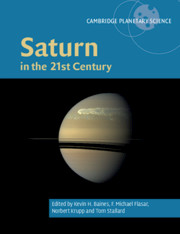Book contents
- Saturn in the 21st Century
- Cambridge Planetary Science
- Saturn in the 21st Century
- Copyright page
- Contents
- Contributors
- Reviewers
- 1 Introduction to Saturn in the 21st Century
- 2 The Origin and Evolution of Saturn, with Exoplanet Perspective
- 3 The Interior of Saturn
- 4 Saturn’s Magnetic Field and Dynamo
- 5 The Mysterious Periodicities of Saturn
- 6 Global Configuration and Seasonal Variations of Saturn’s Magnetosphere
- 7 Saturn’s Aurorae
- 8 Saturn’s Ionosphere
- 9 Saturn’s Variable Thermosphere
- 10 Saturn’s Seasonally Changing Atmosphere
- 11 The Global Atmospheric Circulation of Saturn
- 12 Saturn’s Polar Atmosphere
- 13 The Great Saturn Storm of 2010–2011
- 14 The Future Exploration of Saturn
- Index
- References
3 - The Interior of Saturn
Published online by Cambridge University Press: 13 December 2018
- Saturn in the 21st Century
- Cambridge Planetary Science
- Saturn in the 21st Century
- Copyright page
- Contents
- Contributors
- Reviewers
- 1 Introduction to Saturn in the 21st Century
- 2 The Origin and Evolution of Saturn, with Exoplanet Perspective
- 3 The Interior of Saturn
- 4 Saturn’s Magnetic Field and Dynamo
- 5 The Mysterious Periodicities of Saturn
- 6 Global Configuration and Seasonal Variations of Saturn’s Magnetosphere
- 7 Saturn’s Aurorae
- 8 Saturn’s Ionosphere
- 9 Saturn’s Variable Thermosphere
- 10 Saturn’s Seasonally Changing Atmosphere
- 11 The Global Atmospheric Circulation of Saturn
- 12 Saturn’s Polar Atmosphere
- 13 The Great Saturn Storm of 2010–2011
- 14 The Future Exploration of Saturn
- Index
- References
Summary
We review our current understanding of the interior structure and thermal evolution of Saturn, with a focus on recent results in the Cassini era. There has been important progress in understanding physical inputs, including equations of state of planetary materials and their mixtures, physical parameters like the gravity field and rotation rate, and constraints on Saturnian free oscillations. At the same time, new methods of calculation, including work on the gravity field of rotating fluid bodies, and the role of interior composition gradients, should help to better constrain the state of Saturn’s interior, now and earlier in its history. However, a better appreciation of modeling uncertainties and degeneracies, along with a greater exploration of modeling phase space, still leave great uncertainties in our understanding of Saturn’s interior. Further analysis of Cassini data sets, as well as precise gravity field measurements from the Cassini Grand Finale orbits, will further revolutionize our understanding of Saturn’s interior over the next few years.
- Type
- Chapter
- Information
- Saturn in the 21st Century , pp. 44 - 68Publisher: Cambridge University PressPrint publication year: 2018
References
- 5
- Cited by



